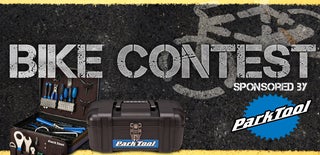Introduction: Push Scooter From an Old Bicycle and Salvaged Parts
My Son dragged home a little bent up push scooter that he found on the side of the road. It had small wheels that could not roll in our sand and the frame scraped in every dip and hole.
We decided it was just not the right fit for our dirt road, so he asked if there was one that would work better. His old bicycle was available, so we set out to cut and stretch it into a push scooter that was more aggressive and off-road capable than what the stores sell. Buying stuff for your kid sucks, building stuff with your kid is awesome.
We started by stripping the bike down to the frame and front forks. I cut out the top tube and cut through the down tube at the seatpost tube. We laid it out for a mock up and decided to cut the down tube at the neck, we only cut partially through so we could bend it and change the rake angle on the neck. We made the deck out of a scrap piece of 1x2 tubing and welded it all together. We put the scooter together for testing and handle bar fit. A set of bars form a dumpster find Abdoer fit perfect.
I tried to include my son in as much of the project as possible so he got to sand off the old paint and paint the frame. I riveted a piece of scrap diamond plate, left over from another project, onto the deck.
Step 1: Things You Will Need.
An old kids bicycle, we used a 16in boys single speed.
Wrenches, to take apart the bicycle.
Some scrap metal for gussets and trim.
1x2 steel tubing, for the bottom tube.
Cutting tools: recipricating saw, hacksaw, or a chopsaw.
A welder
A hammer to persuade things into position.
Angle grinder
Sanding tool, to remove paint.
Paint
Some metal to extend handle bars or some cool salvaged bars.
A drill and bits.
Pop rivets and a riveter.
Step 2: Strip Down the Bike.
This is the best part for including kids, because no power tools are needed.
Remove the wheels, chain, pedals, crank, seat, and the handle bars. While the wheels were off, we greased the bearings and removed the guts for the coaster brake.
We left the front fork on for mock-up purposes.
Step 3: Cutting and Mock-Up.
Cut the top backbone tube off at both ends. Cut the down tube off at the seat tube.
The parts out to see how things will fit. The old top tube was not long enough for my son's feet and we didn't like the angle of the neck.
Step 4: 2nd Mock-up
Cut most of the way through the down tube at the neck, stopping at the bottom of the tube leaving it still attached to the neck. Bend the tube towards the forks to change the angle on the neck. We replaced the old backbone with a piece of salvaged 1x2 tubing. We found the 1x2 tubing in a dumpster, it was a support for an old car radio display case.
Step 5: Grind Down Old Tube Ends.
Grind down the remaining bits of tubing from the neck and seat tubes. I recommending clamping the pieces down with a vice before grinding.
Step 6: Wedges and Gussets
There are some gaps at the top and bottom of the down tube that need filled and strengthened. Take the top tube that was cut off earlier and cut some wedge shaped pieces. Clean off the paint and set them in place. I cut in half some discarded Tacoma rear axle bearing retainers for gussets. To add some additional strength to the bottome of the down tube and to clean things up a bit, I cut an ice cream cone shape from some scrap 18 gauge sheet metal.
Step 7: Welding
I laid our parts out the same as during out mock up and welded them together. Weld the wedges in place over the gaps at the top and bottom of the down tube. Weld the half circle gussets in place. Tack weld the ice cream cone piece of sheet metal on at the bottom of the down tube where it meets the bottom tube. Hammer the ice cream cone into place a little at a time adding tack welds as you go. The tack welds will heat up the metal making it easier to hammer into position.
I tested my welds by taking the scooter for a rough little test run, I weigh 300lbs if it will handle my wieght it will be more than enough for my son.
Step 8: Handle Bars
The original handle bars were to short. We had the luck of finding an old Abdoer machine, and the handles from it made the perfect tall ape hanger handle bars.
Step 9: Sand Down the Old Paint.
Finally the kids can help again. Sand down the old paint, it's not a show piece so it doesn't have to be perfect.
Step 10: Paint
Spray paint is cheap and easy. You can get fancy with it if you want, but we kept it simple. We primered the bare metal and followed that with a couple coats of satin black.
Step 11: Trim
Some scrap aluminum diamind plate fit the bottom tube with a little trimming and was attached with some pop rivets. My son liked the look of the old crank sprocket so we used the bracket from the seat post reflector to attach the sprocket to the handle bars clamp bolt.
Step 12: Ride It.
Now that it's all together let the kid ride it around.

Participated in the
Bike Contest

Participated in the
Epilog Challenge V

Participated in the
Instructables Green Design Contest

Participated in the
Jury Rig It! Contest













